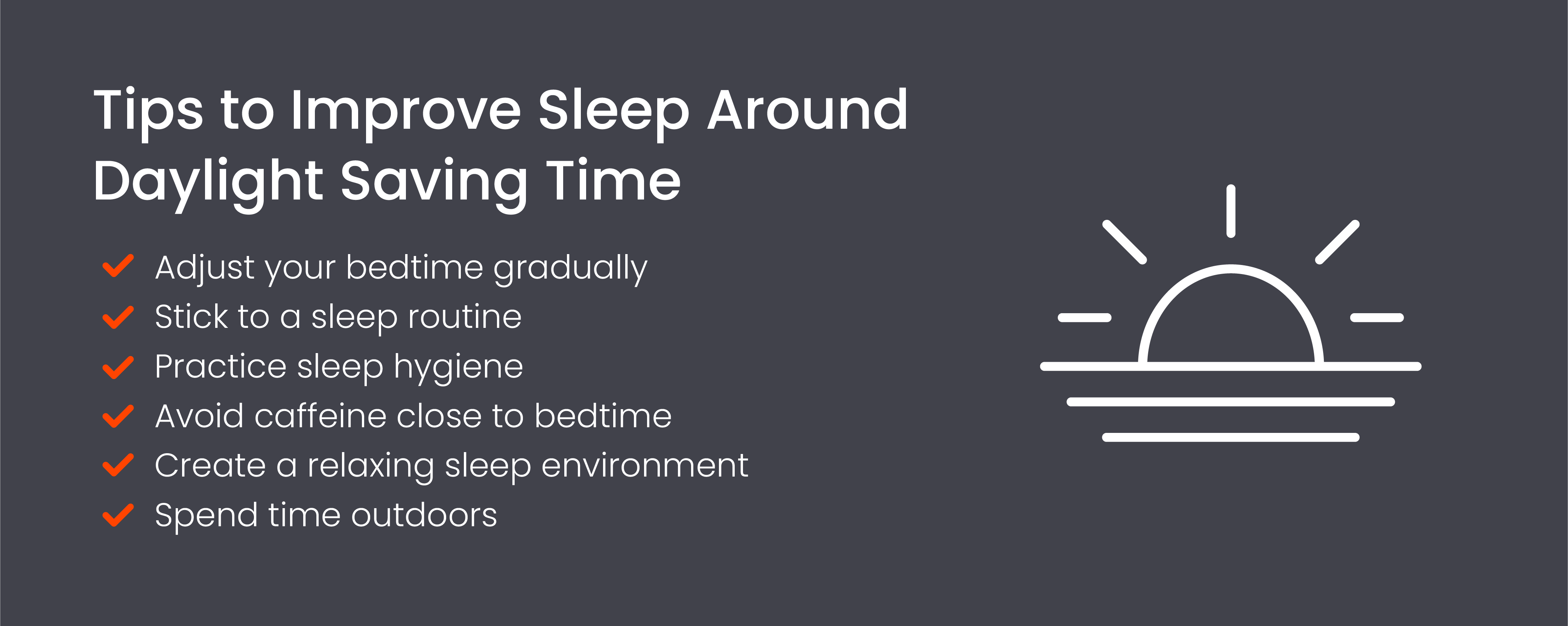But why do many people feel so tired during daylight saving time? Ultimately, losing or gaining one hour of sleep upsets our entire routine, especially when it comes to circadian rhythm. So, what’s the relationship between circadian rhythm and daylight saving time? Keep reading to find out!
- What Is Daylight Saving Time?
- What Is Circadian Rhythm?
- How Does Daylight Saving Affect Circadian Rhythm?
- Tips to Improve Sleep Around Daylight Saving Time
- Key Takeaways: The Connection Between Your Circadian Rhythm and Daylight Saving Time
What Is Daylight Saving Time?
Daylight saving time is a practice that involves adjusting the clocks forward by one hour during the warmer months to extend natural daylight. Then, we adjust them back during the colder months. The primary goal is to make more efficient use of natural daylight and reduce the need for artificial lighting to save energy.
This adjustment typically occurs in the spring, which is why we call it “springing forward.” Then, in the fall, clocks are set back by one hour to return to standard time, known as “falling back.”
Daylight saving time came about during World War I when several countries adopted the practice as a wartime measure to conserve resources. Daylight saving time was again implemented during World War II, and the practice was standardized in 1966.
Since then, many countries, including the U.S., have adopted daylight saving time, although some haven’t.
What Is Circadian Rhythm?
Your circadian rhythm is the internal process that regulates your body’s natural sleep-wake cycle and other physiological processes and repeats roughly every 24 hours. This internal clock is synchronized by external cues, such as exposure to light. Light, especially natural daylight, plays a crucial role in regulating the production of melatonin — the sleep hormone.
As daylight fades in the evening, the body’s melatonin levels increase, signaling that it’s time to wind down. Conversely, exposure to bright light in the morning suppresses melatonin production, promoting wakefulness.
Disruptions to the circadian rhythm due to shift work or irregular sleep patterns can lead to disturbances in sleep, mood, and cognitive performance.
How Does Daylight Saving Affect Circadian Rhythm?
Daylight saving time annually introduces a temporal shift that extends beyond the adjustment of clocks and can significantly affect our internal clock — the circadian rhythm. So, how does daylight saving affect circadian rhythm, and what does it mean for you? Let’s take a look at the relationship between daylight saving time and circadian rhythm:

Disrupts natural sleep-wake patterns
Your circadian rhythm and time change due to daylight saving time can disrupt your natural sleep-wake patterns, causing a sleep debt and making you feel tired. The transition associated with daylight saving time, whether springing forward or falling back, brings a change in sleep duration and quality.
As the clocks move forward, individuals may experience challenges in falling asleep at the adjusted local bedtime due to reduced exposure to morning light. This not only makes it more difficult to fall asleep, but it can also make it more difficult to stay asleep, affecting your ability to reach restorative deep sleep.
Conversely, when falling back to standard time, the earlier darkness of night can lead to drowsiness at an earlier hour. These changes can bring about changes in the quantity and quality of sleep.
Affects mood
Daylight saving time doesn’t just alter our external time markers — it can affect our mood and mental well-being. The disruption to the circadian rhythm due to the time change and various other factors has been linked to an array of mood disturbances. One notable impact is an increased risk of depression and lower mood during the adjustment period.
The abrupt shifts in daylight exposure, especially in the fall when evenings become darker earlier, can contribute to a condition known as seasonal affective disorder (SAD). SAD is a type of depression that occurs seasonally, often in the winter months when natural light is at its lowest. When we adjust our clocks and ultimately spend more time in darkness, we’re more prone to mood-related consequences.
Potential physical consequences
Circadian rhythm disruption has also been linked to various health issues, such as the increased risk of heart attack and stroke. Research suggests a modest but significant increase in the risk of acute myocardial infarction (heart attack) following daylight saving time transitions. This risk is heightened following the spring shift.
Daylight saving time has also been linked to an increase in hospitalizations for ischemic stroke, particularly in the first two days post-transition, suggesting that the disruption in our circadian rhythms due to daylight saving time increases our risk of serious health issues.
Increased risk of motor vehicle crashes
The transition to daylight saving time, especially in the spring, is associated with a small increase in the risk of motor vehicle accidents due to sleep deprivation.
When we spring forward, we’re losing an hour of sleep. The clocks change at 2 am. Very quickly, 2 am becomes 3 am, and you’ve lost an hour of sleep but still have to be up for work and other responsibilities at the same time. This misalignment in circadian rhythm can cause extreme fatigue, resulting in cognitive impairment and car accidents.
Additionally, the shift to daylight saving time in the spring results in darker mornings, which means less visibility on the road during rush hour, potentially contributing to accidents. Analyzing data from fatal accidents in the U.S. from 1996-2017, a study found a 6% increase in fatal motor vehicle accident risk during spring DST, particularly in the morning and in locations further west.
This risk decreases the week following daylight saving time and when we fall back to standard time later in the year, suggesting that daylight saving time and circadian rhythm impact more than just our sleep — the disruptions of our circadian rhythm due to time changes can affect our safety.
Tips to Improve Sleep Around Daylight Saving Time
Navigating the time shift during daylight saving time can be challenging for our sleep routines. Whether it’s springing forward or falling back, the abrupt change can disrupt our circadian rhythm and affect the quality of our sleep. To mitigate the impact of daylight saving time on sleep, consider incorporating these tips into your routine:

- Adjust your bedtime gradually: Transitioning smoothly through daylight saving time involves gradually adjusting your bedtime in the days leading up to the time change. Incrementally shifting your bedtime by a few minutes allows your body to acclimate to the new schedule without the shock of a sudden change. This gradual approach can synchronize your internal clock with the external time, making the transition much easier.
- Stick to a sleep routine: Consistency is key when it comes to maintaining healthy sleep patterns, especially during the adjustments of daylight saving time. Establishing a regular sleep routine signals to your body that it’s time to wind down and prepare for rest. Create a pre-sleep ritual, such as reading a book or practicing relaxation techniques, to help cue your body for sleep. Adhering to a consistent sleep schedule reinforces your circadian rhythm, promoting better sleep quality and overall well-being.
- Practice sleep hygiene: Prioritizing good sleep hygiene is essential for optimal rest. Ensure your sleep environment is conducive to sleep by keeping the bedroom dark, cool, and quiet. Limit exposure to screens before bedtime, as the blue light emitted can disrupt melatonin production. You can also create a sleep playlist to help signal to your brain that it’s time to wind down.
- Avoid caffeine close to bedtime: Caffeine is a stimulant that can interfere with your ability to wind down for sleep. The best time to drink coffee is in the morning, about an hour after you’ve woken up. To promote restful sleep, avoid consuming caffeine in the hours leading up to bedtime. Choose decaffeinated beverages if you need a warm drink before sleep.
- Create a relaxing sleep environment: Creating a calming environment can help you overcome disruptions associated with the time changes. Dim the lights as bedtime approaches and engage in activities that promote relaxation, such as gentle stretching or meditation. Additionally, you can use white noise to sleep, blackout curtains to customize your sleep environment, and a down alternative comforter to lull you to sleep.
- Spend time outdoors: Exposure to natural light can help regulate the circadian rhythm. Spend time outdoors in the morning to maximize daylight exposure. Natural light helps reset your internal clock, signaling to your body that it’s time to wake up and be alert, potentially mitigating the effects of daylight saving time on your sleep-wake cycle and promoting a smoother transition.
Key Takeaways: The Connection Between Your Circadian Rhythm and Daylight Saving Time
The relationship between your circadian rhythm and daylight saving time shouldn’t be ignored, as it can affect various aspects of your well-being, safety, and overall daily lift during the transition. Whether you’re springing forward or falling back, daylight saving time disrupts the delicate balance of your circadian rhythm, potentially making you feel fatigued. But beyond tiredness, it increases the risk of mood disturbances, can have physical effects, and can potentially make driving more dangerous.
Enhance your sleep quality with Layla Sleep. Proper bedding and a comfortable mattress are natural sleep aids, and we offer a range of products to enhance your sleep environment and help you make a healthy transition during daylight saving time. Our memory foam mattress and hybrid mattress provide optimal comfort and support for a restful night’s sleep. Pair them with Layla bedding to create a cozy and relaxing sleep environment.
Browse our selection for more cozy, comfortable, and sleep-promoting products designed to help you get a better night’s sleep regardless of the season.



